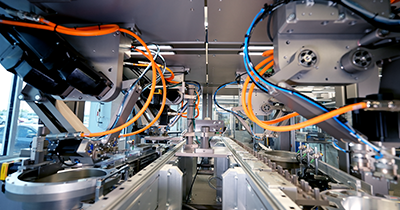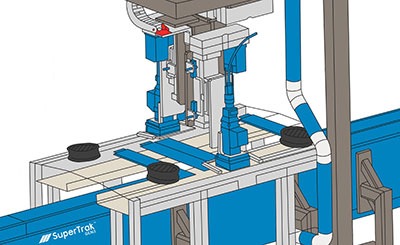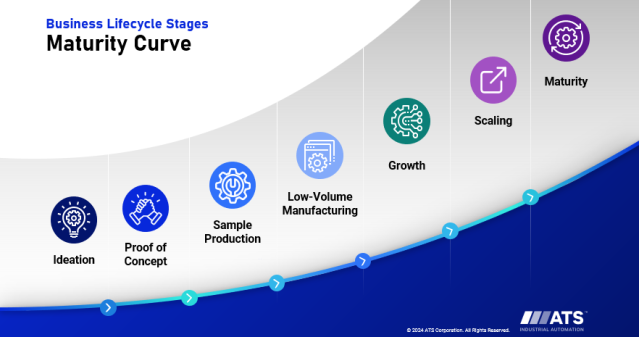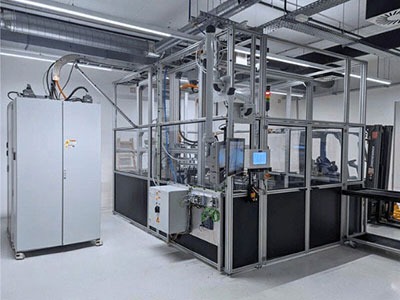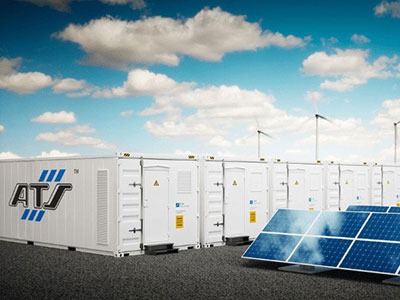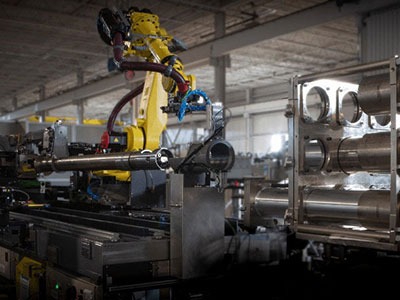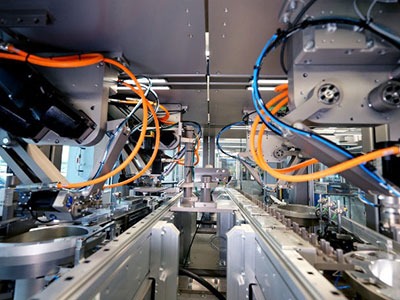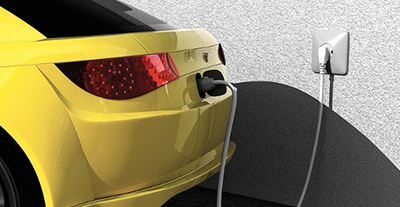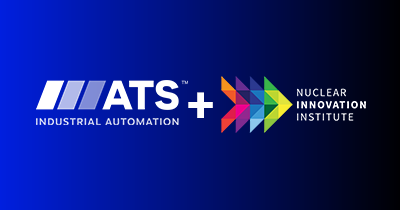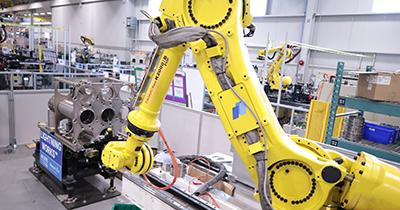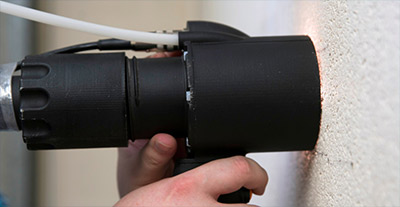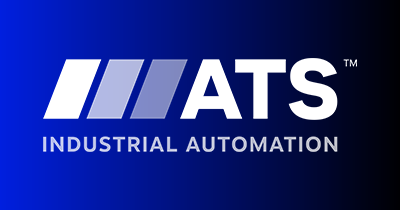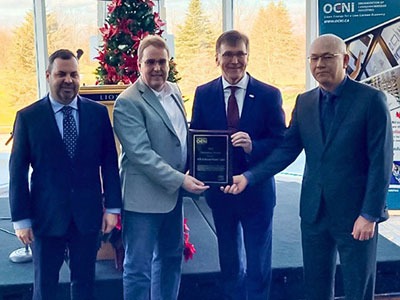May 5, 2022
It’s an exciting time to be involved in the electrification industry. Tackling the battery revolution, from design to manufacturing is not an easy task. Simply stacking batteries is not a model that can scale. There are form factors and design elements that are not fixed in time, presenting significant hurdles. A scalable, modular approach with the right partner is critical for success.
Learn why ATS Industrial Automation is the partner of choice for battery manufacturing and assembly.
- Lessons learned from EV automotive battery assembly.
- How grid storage, wearable devices and other applications can leverage the rapid development in high volume industrial battery production.
- Why adaptable and module approach in product development is a key, to delivering production scale automation.
- Why engaging your suppliers earlier is so crucial for today’s success.
Watch “Manufacturing for Decentralized Energy Storage” Webinar Now
Speakers
Host
David Greenfield
Director of Content, Automation World.
Speaker
Cameron Bruce
Mechanical Design Manager, ATS Industrial Automation.
Transcript
David Greenfield
Hello, and welcome to this Automation World webinar on manufacturing for decentralized energy storage, sponsored by ATS Industrial Automation, a supplier of end-to-end automation systems for electric vehicle battery assembly, energy storage, process automation, and consumer packaged goods assembly and packaging. I’m David Greenfield, director of content for Automation World, and I’ll be moderating this webinar.
One of the major industry trends over the past several years now has been electrification, and its focus on batteries for everything from electric vehicles (EVs) to energy storage on the grid, and even wearable devices. With all this interest in electrification, it’s important to realize that the design and manufacturing of batteries is not a simple task. For example, stacking batteries to provide more power is not a model that can scale. Plus, there are form factors and design elements that present significant challenges to manufacturers in this business.
To learn more about this, we have Cameron Bruce from ATS Industrial Automation, to share lessons learned from electric vehicle battery assembly, about how developments in high volume industrial battery production can impact grid storage, wearable devices, and other applications. And, why an adaptable and modular approach to product development is key to delivering production scale automation. At the end of Cameron’s presentation, we will have a questions session, so feel free to enter your questions for him at any point during the webinar. And with that, I’ll go ahead and turn the presentation over to Cameron.
Cameron Bruce
Hello, and welcome to the presentation on manufacturing for decentralized energy storage. It’s an exciting time to be involved in the electrification industry. During this presentation, we’ll explore the challenges of battery production, the importance of selecting the correct automation partner, and how every day matters.
I am Cameron Bruce, and I’ll be taking you through some of these challenges that we all wrestle with, such as the time to market and evolving technologies. I’ve been part of ATS Automation Tooling Systems for over 15 years, designing automation in a variety of fields including medical, nuclear, consumer products, and traditional automotive programs. With the shift to electrification, namely EVs and grid storage, opportunities arose to contribute to this new and exciting business. I took a lead role in several large-scale module and pack assembly projects for the EV industry. While I’m not an expert in battery chemistries, with experience in both cylindrical and post-cell automation, I can tell you that battery production is not a simple problem to solve, and it takes strong partnerships and creative solutions to get to market.
As an EV owner, I see a green future where decentralized energy production and storage revolutionize our way of life, from transportation to our use of everyday items. By now, many of you are aware of the surge in electric vehicle demand and the continual growth of the EV. Automotive market share battery technology and the declining cost of a kilowatt hour is opening opportunities for broader battery adoption in multiple sectors. Combine this with other transportation demands like commercial trucking, public transport, as well as grid storage, and the demand on battery production is overwhelming.
My newsfeed is filled with a stream of battery development projects, from massive grid storage installations to new and exciting chemistries promising to be the next step change in battery technology. A quick search reveals that investment in battery production is widespread. You can see here several articles which drive questions and conversations around what batteries will mean to our energy mix future, the importance of material sciences in the economics of battery production, the vast amounts of money that automakers are spending on electric vehicle production, and even what battery home storage solutions will look like in the houses we build for the future. This is all while research and development in this field continues to push technological boundaries and reduce costs.
Here are a few examples. Each of the products shown here has a different form factor and possibly chemistry, as well as different customer requirements and scale. But they also have many similarities. The right ideas, new designs, and manufacturing methods from one industry can be easily ported over to another. Battery modules, such as those seen here in a typical EV skateboard, can, with some modification, be boxed up in containers for grid storage. Cell welding techniques from cylindrical form factors, also possibly found in an EV, easily transfer over to smaller applications like power tools. This drives costs lower and opens smaller capital markets. Furthermore, principles from large-form-factor pouch cell handling in the EV industry can carried over to miniature wearable batteries. Each of these products requires flexible automation to keep costs low while keeping up with the changing product requirements.
Batteries aren’t new; Alessandro Volta created the first true battery in 1800, from something as simple as a lemon with a few strips of metal. And it’s likely every one of you has a shelf or a drawer at home where these seemingly mundane products are kept. So how did this 200-plus-year-old technology suddenly become one of the most important industries in the world? How did we get to a point where manufacturing simply cannot keep up?
A big part of this is the threat posed by climate change. Climate change is now a mainstream concern. And green technology industries are supported by huge investments motivated by political and financial factors. Batteries are a key enabling technology in two major sectors, namely electric vehicles, and grid storage. Grid storage alone is expected to be a $1 trillion industry in the next few decades.
Without batteries, these sectors would either not be possible or struggle to expand. The second consideration is that you can’t use a lemon to power your smartwatch and developing battery technologies have simply made new ideas and products possible. Automation is the only path to achieving the lowest cost per kilowatt hour. Currently, most of the world’s battery production takes place in China; we need low-cost manufacturing solutions to promote the reshoring of battery production to North America and Europe. This improves the health of the overall global supply chain and boosts product content from local industries. Investment in North America and Europe also promotes a feedback loop to the research industry to keep these regions competitive in the next generation of battery technology.
On top of the problem of meeting demand and managing our way through a global landscape, we’re currently experiencing a relentless supply chain crunch. Securing products across all industries, from semiconductors to wire insulation, to robots, to raw steel and aluminum, takes longer. Every company needs to be keenly aware of this challenge and be looking further ahead to plan for startup production. What was hopefully going to be a temporary blip is now forcing us all to realize that this could be the new normal for the foreseeable future. So, the demand is actual. But why is this a problem?
The Magic Triangle
Consider this magic triangle of factors converging to form a perfect storm for supply chain capacity. First, battery technology is changing and improving at a rapid pace. Lithium ion is the core technology of today, with many recipe developments in the works to improve capacity as well as charge and discharge times. Let’s say batteries are utilized in some applications, and while their use may still be specialized, their eventual arrival into the broader EV and grid storage markets could shake up existing supply chains as companies pivot to attain the most competitive technologies.
The second is project timing. Large battery assembly projects can take two to three years from project start at the request and proposal stage, to full production ramp. Batteries are complex multidisciplinary programs requiring substantial capital and time investment. The battery is an integral part of the product design, whether it’s in a vehicle chassis or in the thinnest form factor possible for a handheld device, and it needs to arrive in high volumes to support the rest of the project manufacturing.
Third, limited flexibility means that automated assembly lines cannot be easily changed, and that flexibility is not built into the new battery designs. For example, what if solid state batteries do come to market? Or what happens to the battery shape if the consumer now wants a smartphone that folds? Will the existing product designs roll the latest technology into a current form factor? Or will the product design and battery take on an entirely different shape? This makes automation projects a moving target and, as a result, programs with more than 400 change orders have been seen in some automation projects.
Automation:
Opportunities in the Green Revolution
Despite not being a brand-new industry, battery manufacturing is not a solved problem. The correct automation solution is how battery manufacturers can stay on the front row of the race to the lowest cost per kilowatt hour. But why is this a problem even worth solving? What are the opportunities?
As we’ve discussed, through automation, we can accelerate the Green Revolution, bolster growth and domestic production, continue investment in battery research, and drive costs lower. This will fuel broader battery adoption, and we need automation to get us there. At some point, there will be an inflection point where battery production will be more economical than on-demand energy, as finite resources become increasingly difficult to produce and government incentives make commodities like coal less attractive, perhaps even to the point where free renewable energy generation like wind and solar, combined with battery storage, brings the cost of delivering a kilowatt hour below the current market rate. This could unlock significant capital spending in this area, and greatly improve the return on investment when considering battery technology.
But with every opportunity comes some level of risk. It’s important to select the correct automation partner. The wrong automation partner can easily underestimate battery complexity and the ramp required to meet demand. Automation, if not designed to handle multiple product types, can be rendered obsolete or require substantial redesign as new variants emerge. Automation needs to be as future-proof as possible.
This brings us to timing. Being beat to market by competitors because the automation solution could not deliver on time is a major concern. The green revolution is happening one way or another, and companies with the right automation solution will get there first. By embracing high volume, low-cost automated production, North America, and Europe can be competitive in the global market. You don’t need to face these risks alone.
ATS Industrial Automation:
Successful Partnerships Matter
Now a little bit about us at ATS Industrial Automation. ATS is the leading global automation solutions provider. With a deep-rooted history, turnkey automation, and an ever-expanding capability set, ATS has the capacity and flexibility to partner around the globe to work with our customers to achieve common goals. Specifically, ATS has a strong history of success in partnerships within the battery industry. With 20 years of battery automation experience and more than 75 battery automation projects deployed, we are well suited for partnerships in the industry. Some of our core competencies along the production evolution are listed here. With this volume of completed projects, it’s clear ATS has a strong partner base who have entrusted us with the success of their electrification programs. We’re excited to work with these companies in this constantly changing and challenging industry. Here is a short video showing where ATS is at today.
Every day matters.
These words define ATS Industrial Automation.
Demand for new technology isn’t slowing down. Optimizing output to meet demand is crucial. At ATS Industrial Automation, we understand that. Strategic partnerships that leverage automation with precision processes are essential to success. Our customers gain efficient integrated solutions that are modular and adaptable to market demands.
Problem solving, material handling, scaling, and a long list of other challenges require expertise to overcome. Success means working with a partner who has in-depth industry knowledge or a systematic approach. Our clever digital and agile systems set us apart. Our careful attention to detail provides customers a sense of security that their production systems will consistently deliver high-quality products.
Staying in step with change means transforming businesses as they happen. Resources spent offsetting delays and unexpected shutdowns do not yield growth. Our commitment to our partners is to guide their vision into reality with repeatable, high-caliber results on time and on budget.
A partner for the future, because at ATS Industrial Automation we know: every day matters.
Visit ATS Industrial Automation to learn more.
As you can see in the video, we’re very excited about the work we do, not only technically, but in ways that matter to our customers and with a strong focus on partnership.
Challenges in battery manufacturing exist in several commercial and technical areas; to succeed, a shift in perspective is necessary. The typical procurement model for volume automation equipment no longer applies. The industry is shifting from being an automation supplier to being an automation partner to develop the solutions as the product evolves. This is the only way to ensure that volume production is ready to go as soon as the product has stabilized and is the only way to address the overwhelming demand for batteries globally. In addition, selecting a partner with the heavy lifting of automation development behind them leads to standardized solutions, helps minimize technical risks, improves supply chain security, and minimizes costs.
Throughout this process, ATS has a passionate team that can empower product designers to make the best decisions early and minimize disruptions as startup production nears. A partnership is also making sure that both parties are stable and able to support each other over the automation lifecycle. Another critical benefit is having an automation partner with the ability to scale operations. ATS, with its global footprint, is up for the challenge. And there’s something to be said about local partners in a world of uncertainty. Keeping work in a relatively closed market helps maintain partnerships and a team-building environment, which ultimately leads to the shortest path to a successful project. Once you have a partner in automation, make sure you have the technical skillset to not only convert your ideas into a production reality, but into a reality that is high volume, low cost, and puts quality above all else.
Next are a few examples where ATS excels, using our knowledge to mitigate risks and deliver quality automation solutions on time. An automation partner who is an expert in laser welding is vital. Laser welding has emerged as the preferred technology for cell bonding to the lattice structure. With our in-house laser lab, ATS can develop a weld process for our customers with similar or dissimilar metals, including nickel plated copper to nickel plated steel substrates, or perhaps develop an aluminum laser welding process without filler wire or shielding gas while still producing quality welds. However, welding components that are not in contact with each other usually yields poor results. ATS has developed dozens of laser welding clamping applications to achieve a reliable zero gap while working around the intricate geometry of battery design and being nonconductive when necessary.
Finally, ATS can provide fully automated solutions in either standard or customized class 1 laser enclosures for safe operation on the factory floor. Consider a typical electric vehicle battery pack full of cylindrical cells; there can be upwards of 6,500 cells strung together, each of which requires a connection to positive and negative terminals, resulting in 13,000 individual joints in the required volumes. This is only economical through a robust laser welding process. Each of these weld sites is critical to product quality, and bad welds directly impact vehicle performance. In a production process with a 98% first-time quality pass rate, a weld process with 13,000 welds needs to have a 99.98% success rate.
And there’s more. This process needs to be fast; 3D galvo heads can weld very quickly. But the real trick is that robust automated clamping solution that I mentioned earlier, that reliably couples the bus strings to the cells, while at the same time working around the product geometry. That zero-gap condition between the lattice structure and the cell surface is vital to a good penetration weld.
What separates ATS from other companies is our strong partnership with some of the major laser manufacturers to help develop new technologies such as the integration of real-time monitoring with scanning galvo weld heads. This monitoring inspects the quality of each weld by measuring the key hole of the weld directly and feeds forward to the main process laser fiber or motion platform. This allows the tooling to course correct or modulate power on the fly. Gone are the days of indirectly measuring the weld by means of visualizing the plume. Coaxial process monitoring lasers can see through the effluent and plumes given off by the process to measure a variety of features while simultaneously welding. This direct measurement is the secret sauce to real-time weld monitoring and ensures the highest quality process to build on the value of real-time monitoring.
Consider that end-of-line testing might result in 1000s of dollars of scrapped work in progress until a weld problem is identified. Maybe one of the sites in the clamp matrix has become damaged, and there are now repeated weld failures at that contact site over dozens of modules. With in-process monitoring and some careful development, these weld failures are identified at the source and can be dealt with immediately. Validation of the real-time technique is also important to build process confidence. This can be handled in ATS Industrial Automation’s dedicated laser lab via tensile strength tests, cross-sectioning, and other means to verify the weld penetration and strength. And of course, knowing this information earlier in the stages of your product development is better than later. An important question is: Does your automation supplier have the facilities and lab equipment available to support and test your process, or demonstrate process capability through samples and coupons, before the final product is complete?
It’s not uncommon to submit coupons or pre-production level components to the laser lab for process validation. And prototype work is just the beginning. ATS does not stop at the lab. We use this early development knowledge and the lessons learned with our customers to design and build world-class production laser welding equipment.
Following laser welding in the battery processes there are various challenges in dispensing. As material science for low specific gravity and highly thermally conductive materials continues to evolve, thermal interface material (TIM) is becoming less abrasive, less damaging to process equipment, and even injectable in some cases; the optimum distribution of TIM will promote battery cooling in more effective ways while keeping weight down.
While not suitable for all battery products, the application of TIM is a key process step that requires substantial equipment investment and can be iterative to get it right. TIM is almost exclusively a two-component material, and thus must be metered carefully. It’s typically heavy and highly abrasive. A common approach is to mount the servo metering equipment to the elbow of a six-axis robot and allow the robot to trace the desired pattern, provided there is sufficient cycle time. This is a highly flexible and suitable approach. However, this may not produce the required volumetric flow to meet total throughput, and thus additional stations may be required. This multiplies the capital costs of the dispense and motion platform equipment.
While not suitable for all battery products, the application of TIM is a key process step that requires substantial equipment investment and can be iterative to get it right. TIM is almost exclusively a two-component material, and thus must be metered carefully. It’s typically heavy and highly abrasive. A common approach is to mount the servo metering equipment to the elbow of a six-axis robot and allow the robot to trace the desired pattern, provided there is sufficient cycle time. This is a highly flexible and suitable approach. However, this may not produce the required volumetric flow to meet total throughput, and thus additional stations may be required. This multiplies the capital costs of the dispense and motion platform equipment.
ATS has experience in developing robotic systems for maximum flexibility, as well as bespoke dispense solutions that optimize pattern density and volumetric flow for the given equipment footprint. After TIM is dispensed, it’s typically concealed in the product and never seen again. Knowing that you’ve dispensed the correct amount of material in the correct location is critical to a quality product. Real-time volumetric monitoring through laser scanning tools can measure the profile during dispensing, guaranteeing the correct amount and shape of material is applied.
And TIM isn’t the only critical dispense operation in the wide variety of battery manufacturing applications. Batteries can be exposed to a number of environmental conditions and, in some cases, high vibrations. In some products, securing the batteries to a carrier is important to keep them well supported and to remove the stress from sensitive weld joints.
As a quick example, to secure our customers’ batteries, ATS, along with our dispense partner, built automation which could rapidly jet dots of UV curable adhesive to the carrier substrate, which was approximately 50 millimeters away, with a one-millimeter accuracy. This permitted precision adhesive dispensing, in a programmable pattern at high speeds to maximize throughput while maintaining adhesive holding power. Potting, used in applications such as final battery retention or bonding of thermal couples for temperature monitoring, is often another key dispense process in battery automation. Not to mention other dispense applications, including fluxing cleaners, product sealers, and electrolyte fill, which you can see here.
Knowing that batteries in either modules or packs meet their desired metrics is essential to validating key processes before ramping to production. Whether incoming cell inspections such as open circuit voltage measurement or leak testing on the coolant circuit, each successful production line has both in-process and end-of-line testing to help minimize scrap and ensure a quality product. Other essential testing requirements are likely to include HIPOT testing, DCIR testing, and low voltage circuit testing to validate that the battery’s internal voltage monitoring system is functioning correctly. To couple with connection points on the battery, module, or pack, the automation tooling may require custom connectors to ensure a long-lasting and reliable contact. On the back end of testing is the data banking of all this information. So, each product has a credible birth certificate right from the production floor to the final consumer.
At the core of ATS is a long history of high-speed flexible material handling solutions. Over our nearly 45-year history, we have developed many customized handling solutions, leading to a substantial product portfolio, including our SuperTrak GEN3™ and SuperTrak MICRO™ platforms. These highly flexible asynchronous transport systems are capable of speeds of up to four meters per second and accelerations up to 4g+, with a plus/minus 10-micron positioning repeatability and payload capacities of up to 10 kilograms. High-speed systems such as SuperTrak CONVEYANCE™ Platform allow products to spend more time in processed stations and less time in transit. The asynchronous behavior allows material flow to seamlessly switch between single or multiple processing. This allows the automation team to right-size the amount of equipment on the system, to maximize throughput without unnecessary capital expenditure on stations that do not directly improve throughput. Not only can the SuperTrak CONVEYANCE™ Platform get from station to station rapidly, but it can also forecast its pallet position to the upcoming station tooling. This allows coordinated motion with the next station as the pallet comes into position, further increasing process time to a point where SuperTrak can operate in a continuous motion fashion.
ATS has also developed a variation of the original platform which has historically run horizontally. We turned it on its side to run vertically. This allowed process equipment to work on both sides of the pallet at once and unlocked high-speed processing opportunities for large form factor pouch batteries. Combined with our standard chassis, SuperTrak CONVEYANCE™ Platform is also modular, and we can add new sections for future expansion with ease, furthering the capacity of the initial asset.
Full digital control of the palette location allows for easy adaptation of a number of product form factors within the same palette tooling. And because it’s a linear motor, it can work in combination with other motion axes, reducing the individual station complexity and tooling requirements. What I mean by this is, for example, two perpendicular axes, one being the SuperTrak CONVEYANCE™ Platform and the other being a station-mounted servo, while both are linear on their own, they can work together to trace a circle. ATS has successfully deployed our SuperTrak CONVEYANCE™ Platform into hundreds of systems, including this one, which processes 60 cylindrical cells per pallet every 2.5 seconds; that’s a cell-on-cell rate of 42 milliseconds.
Full digital control of the palette location allows for easy adaptation of a number of product form factors within the same palette tooling. And because it’s a linear motor, it can work in combination with other motion axes, reducing the individual station complexity and tooling requirements. What I mean by this is, for example, two perpendicular axes, one being the SuperTrak CONVEYANCE™ Platform and the other being a station-mounted servo, while both are linear on their own, they can work together to trace a circle. ATS has successfully deployed our SuperTrak CONVEYANCE™ Platform into hundreds of systems, including this one, which processes 60 cylindrical cells per pallet every 2.5 seconds; that’s a cell-on-cell rate of 42 milliseconds.
Finally, because SuperTrak CONVEYANCE™ Platform is a standard ATS product, it can be rapidly produced and deployed, bringing battery manufacturing capacity to the production floor faster than other comparable systems. This in turn also reduces the technical risk associated with transport systems, as ATS has a suite of tools developed for optimum operation of this platform, all while reducing costs.
Increasingly, our customers want to be assured that their automation will be successful even before it hits the assembly floor. Digital tools are there for us to simulate and verify calculations, designs, and layouts before any manufacturing starts. Solutions like Digital Twin take existing 3D geometry from design and operate the line through the same PLC code that will eventually drive the physical components. This not only debugs any coding issues, but it also identifies any problems in the design or motion profile before a much more costly discovery in the physical tooling is made. This gives rise to the idea of virtual commissioning and cold builds, where customers with extremely tight timelines can verify the function of the line digitally, and therefore have the line set up and operational on their factory floor for the first time, with a high degree of confidence that the machine will be successful. Once installed, ATS’s involvement with the equipment doesn’t end. Tools like Illuminate™ keep ATS connected to the automation equipment to monitor its performance and help our customers diagnose issues.
Further, ATS has developed in the field of digitizing automation. Our Industrial Automation group has now fully rolled in the expertise of our process automation partner into our workflow. This tightens the bond between design and simulation and allows ATS to provide its customers with the earliest indication of the line performance. The 100-plus engineers will work closely with designers in North America to rebuild the kinematics of solid model geometry to represent the physical world. We’re able to visually demonstrate automation, like pallets moving through stations in real-time or pick-and-place operations that load components. This provides throughput feedback not only to our customers but also to our design teams to iterate and further improve line performance.
For example, defining a different robot sequence may yield an overall cycle time improvement. The simulated path between a series of operation points may show an improvement over the original concept sequence, and thus provide grounds for feedback on the design. All these strategies are executed with the purpose of shortening delivery times, reducing costs, and increasing productivity. In addition, this strengthened partnership only increases our combined ability to serve our customers with an expanding footprint in Europe while supporting continuing operations in North America. And that only further positions ATS as a global leader in automation. We have 40 plus years of experience, have delivered 1000s of turnkey automation lines, and have a growing employee base of over 6000 team members, with operations in 20 countries, with 20 facilities, and 50 plus offices. ATS is also a publicly traded company with strong financials, and we’re growing.
The ATS Industrial Automation production facility in Lewis Center will make machinery for GM’s automated battery pack assembly lines.
“This is a place that you can be proud to work. We can be a part of that journey. We can build, we can grow, we can develop together. And we can have future employees.”
Andrew Hider,
ATS Automation, CEO.
As you can see, recently, ATS has been excited to announce the grand opening of our battery manufacturing facility in Ohio. And in case you missed it, that was 100 new jobs this year and up to 500 by 2025. This builds on ATS’s already substantial ability to serve the battery and electric vehicle industries, not only in manufacturing capacity, but in design as well. I’d like to close by saying, on a personal level, how excited I am to be part of an organization that is shaping the future of battery production. I see a bright road ahead for what battery adoption, and EVs, and grid storage mean for our everyday way of life, not only for obvious environmental and energy security reasons, but also for furthering battery development here in North America and Europe. Because of this, it’s clear to me and to all of us at ATS, to bring this future to reality, every day matters. Thank you very much for your attention, and I look forward to working with you in the future.
Question 1: Process and Tools Enable Customers to Get Ahead of Change
David Greenfield
Well, thank you, Cameron. Before we get started with the question-and-answer session, I would like to take just a second to remind our viewers that if you have a question for Cameron and you haven’t submitted it yet, now is the time to do so; you can do that right through the webinar interface. But Cameron, we did already get a few questions in during your presentation. So, I’ll go ahead and start with those as more questions come in. One of the questions that we got asks if ATS Industrial Automation has any processes or tools that help you and your customers stay synchronized with all the rapid product changes that you mentioned in your presentation.
Cameron Bruce
Sure. Beyond regular communication with our customers –something like a registered file transfer– we encourage our customers to maintain revision control over their product designs that are submitted to ATS. This allows us to quickly establish the current state of the product, as often the product gets ahead of the automation. So having our customers keep an active revision control helps make sure the product and the automation solutions are in lockstep as we move through the process.
Question 2: Welding
David Greenfield
Okay, thanks, Cameron. Another question we’ve got here is asking about some of the welding processes that you mentioned. In this question specifically, what are the types of welding that ATS sees as being used most in batteries now, and what have been your experiences with them?
Cameron Bruce
Okay, great. We see a number of welding applications in the battery space. Common to all projects are cell-on-cell welding and bonding processes. And it’s typically handled from what we’ve seen and where we are really developing, in laser welding, like I mentioned. And whether it’s cylindrical or pouch cells, we’ve successfully integrated both solutions, not only from a laser processing selection point of view, but also from the customized clamping solution that I talked about earlier. In addition to laser welding on cells, there are also applications to weld larger bus strings together, and applications where we’ll weld the final case of a module to help produce a leak-tight seal so that during a battery venting event, the venting is directed not through the case, but only at specific design points.
Question 3: Digital Twin
David Greenfield
Okay, another question we’ve gotten in Cameron is that in your presentation, you made mention of Digital Twin technology. And this viewer is asking how much, in your experience, a typical Digital Twin costs for the type of applications you were mentioning. And can you expand more on the benefits of using the Digital Twin?
Cameron Bruce
Sure, no problem. So Digital Twin isn’t as much of a product as it is a process that follows along with the scale of the project and to the level of depth that our customers are interested in. For example, highly automated cells will benefit more from Digital Twin and some of those other digital tools to really map out the assembly process and the throughput, maybe more so than some of the manual or automated assembly stations. As far as the costs go, it’s really something that we work with our customers on at the beginning of a project development and scope out the project and how Digital Twin can help that project. And that’s something that we can do very early on once we understand what the scope of the project is.
Question 4: Battery Assembly Considerations
David Greenfield
Okay, we’ve got another question here about a battery assembly. In this one, the viewer is asking, what’s the typical cost of a battery assembly line today in 2022?
Cameron Bruce
Sure, sort of like the last response, there are a wide variety of definitions of what a battery assembly line is. We’ve worked on everything from lab setups to pilot lines and then fully automated production lines that are the size of a factory. And then, even in fully automated lines, the cost of the product is still affected by a number of factors. First is the product design. In this respect, how much of the product design really needs to be assembled automatically, and how much of it should be assembled manually? We can work with our customers to scale where it makes sense to apply automation and where it makes sense to rely on manual intervention. It depends on how many components are in the product and how difficult they might be to assemble. Fitting connectors that require multiple manipulations could drive tooling complexity. And then the other thing to consider is how many actual product variants are being run on the assembly line at the same time? This idea of running like a flex line, or multiple production lines, and we’ve done both huge factory lines with a dozen different variants, or what I would call product matrix projects, can drive significant complexity into the automation, and it’s important that we look with our customer at the product design for common features that we can use to make the best use of one set of tooling over a broad product mix.
I also want to say that there are a number of process parameters that define the requirements for a successful product. And what I mean by processes are some of those key technologies that I talked about: laser welding; if there are very small areas to clamp the product, that can be more challenging and drive some costs. We talked about dispensing and how much area is available to dispense, how much material needs to be dispensed, how precise the volumetric control needs to be, and the shape of that pattern. And then finally, as far as costs go, throughput, we’ve done lines that produce 10 jobs per hour, and we’re working on lines that are producing north of 50 jobs per hour. And obviously, you can imagine that’s going to drive a different cost and automation. To wrap that up, it’s really about working with our customers as early as possible in terms of what they want to automate, how they want to automate, and to what extent we need to drive complexity and automation.
Question 5: Assembly Line Production Timeframes
David Greenfield
It looks like we’ve got time here for one more question. We’ve got another question here that just came in about battery assembly line production. And this one is wondering, what are the typical timeframes for battery assembly line production?
Cameron Bruce
As of 2022? Yes, the supply chain is on everyone’s mind these days. And again, it depends on exactly the scale. But let’s assume the question is about high-volume production lines. We’re seeing times in the 20 to 23 months for sort of the start of production from request to proposal, our initial engagement with our customers to a final production ramp up. ATS is keeping a close eye on our supply chain and is working with our suppliers to secure inventory as much as possible, to help mitigate supply chain risk as much as possible.
David Greenfield
Okay, well, thank you for joining me for this webinar, Cameron. And thanks, of course, to all our viewers. If we didn’t get a chance to answer your question in the session today, you will receive a response via email from ATS Industrial Automation. Thanks again for joining us.
Cameron Bruce
My pleasure. I really enjoyed it. Thank you.
Every project is unique. Allow us to listen to your challenges and share how automation can launch your project on time.



